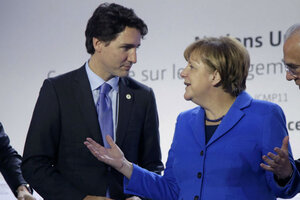Canada's new carbon tax: Too much government meddling, or not enough?
Canada's Prime Minister Justin Trudeau unexpectedly announced a carbon tax Monday. The tax, which goes into force in 2018, will apply to all provinces that have not implemented their own carbon pricing scheme by that time.

German Chancellor Angela Merkel talks with Canada's Prime Minister Justin Trudeau as they attend a meeting on Carbon Pricing on the opening day of the World Climate Change Conference 2015 near Paris. Mr. Trudeau announced on Monday a nationwide carbon tax that will enter into force in 2018.
Jacky Naegelen/Reuters/File
“There is no hiding from climate change,” Canadian Prime Minister told the country’s parliament on Monday. His proposal? A federal carbon tax.
The federal carbon tax comes into force in 2018 – if provinces and territories have not implemented a carbon tax, or cap-and-trade scheme, of their own by then. The tax will begin at $10 (Canadian; US$7.60) per metric ton, then increase by C$10 annually until it reaches C$50 (US$38) in 2022. A C$50 carbon tax would increase pump prices by C11 cents per liter (42 cents/gallon), according to The Globe and Mail. Mr. Trudeau said that all revenue from the scheme would remain in the province or territory where it was generated.
The plan is intended to help meet the climate commitments Canada made at the Paris conference. It has found critics on both sides of the aisle, however: Some provinces have criticized the heavy-handed approach as damaging to provincial economies, while environmentalists say the proposal does not go far enough.
“We’re struggling a little bit to understand where the prime minister’s message came from today, and what’s going to happen moving forward,” said Margaret Miller, Nova Scotia's environment minister.
As Trudeau made his announcement Monday, provincial environment ministers were meeting with their federal counterparts in Quebec to discuss carbon pricing options. Ms. Miller, along with Scott Moe, Saskatchewan environment minister and Perry Trimper, minister of environment and conservation for Newfoundland and Labrador, walked out in protest of the Trudeau announcement.
Historically, provincial premiers have been able to develop their own policies with regard to carbon emissions. British Columbia, for instance, has had a carbon tax since 2008, while Ontario and Quebec have a cap-and-trade scheme. Saskatchewan Environment Minister Scott Moe called the decision as a “betrayal” of the cooperation between federal government and provinces that Trudeau promised.
Opposition to the plan centers on the economics of a carbon tax. The low oil price has hurt some of Canada’s Western provinces. Adding a carbon tax, they argue, will further damage competitiveness and hurt consumers. Saskatchewan Premier Brad Wall described the plan as “one of the largest national tax increases in Canadian history.”
With that in mind, Alberta Premier Rachel Notley said she will agree to the C$50 increase by 2022 only if the federal government approves an oil sands pipeline. She considers the pipeline a “fundamentally important economic piece that Albertans need.” Alberta’s carbon pricing scheme – scheduled to come into force in January – currently tops out at C$30 a ton.
According to Trudeau, some form of carbon pricing already applies to 85 percent of the Canadian economy. His goal: bringing this to 100 percent. But some say it’s not enough.
“If we persist with Harper-era greenhouse gas targets that are among the weakest in the industrialized world, we will fail to ensure Canada does its part in holding the global average temperature increase to no more than 1.5 degrees Celsius,” Canadian Green Party Leader Elizabeth May said in a statement.
The United States currently has no equivalent to the carbon tax proposed by Trudeau. A group of predominantly northeastern states have cap-and-trade schemes, while several others have state emissions standards limiting carbon dioxide emissions. The Supreme Court is reviewing the legality of the Obama administration’s Clean Power Plan, which would cap emissions from power plants nationwide.

